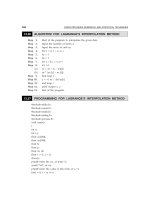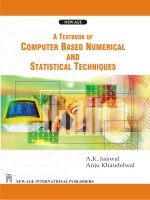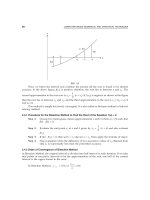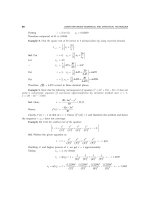A textbook of Computer Based Numerical and Statiscal Techniques part 53 ppsx
Bạn đang xem bản rút gọn của tài liệu. Xem và tải ngay bản đầy đủ của tài liệu tại đây (118.19 KB, 10 trang )
506
COMPUTER BASED NUMERICAL AND STATISTICAL TECHNIQUES
Sol. Given that
n
1
= 800, n
2
= 1200
p
1
=
X
n
1
1
=
800
1000
=
4
5
;
p
2
=
X
n
2
2
=
800
1200
=
2
3
P =
pn pn
nn
11 22
12
+
+
=
XX
nn
12
12
+
+
=
800 800
1000 1200
+
+
=
8
11
;
Q =
3
11
Also, Null hypothesis H
0
: p
1
= p
2
i.e.,there is no significant difference in the consumption of tea before and after increase of
excise duty.
H
1
: p
1
> p
2
(right tailed test)
The test statistic, Z =
pp
PQ
nn
12
12
11
–
+
F
H
G
I
K
J
=
0 8 0 6666
8
11
3
11
1
1000
1
1200
.–.
×+
F
H
I
K
= 6.842
Conclusion: Since the calculated value of |Z| > 1.645 also |Z| > 2.33, both the significant
values of z at 5% and 1% level of significance. Hence H
0
is rejected i.e., there is a significant
decrease in the consumption of tea due to increase in excise duty.
Example 12. In two large populations there are 30% and 25% respectively of fair haired people. Is
this difference likely to be hidden in samples of 1200 and 900 respectively from the two populations.
Sol. P
1
= proportion of fair haired people in the first population = 30% = 0.3; P
2
= 25%
= 0.25; Q
1
= 0.7; Q
2
= 0.75.
Here H
0
: Sample proportions are equal i.e., the difference in population proportions is likely
to be hidden in sampling.
H
1
: P
1
≠ P
2
Z =
PP
PQ
n
PQ
n
12
11
1
22
2
–
+
=
03 025
03 07
1200
025 075
900
. .
−
×
+
×
= 2.5376.
Conclusion: |Z| > 1.96 the significant value of Z at 5% level of significance. H
0
is rejected.
However |Z| < 2.58, the significant value of Z at 1% level of signficance, H
0
is accepted. At 5%
level, these samples will reveal the difference in the population proportions.
Example 13. 500 articles from a factory are examined and found to be 2% defective, 800 similar
articles from a second factory are found to have only 1.5% defective. Can it reasonably be concluded that
the product of the first factory are inferior to those of second?
TESTING OF HYPOTHESIS
507
Sol. n
1
= 500
n
2
= 800
p
1
= proportion of defective from first factory = 2% = 0.02
p
2
= proportion of defective from second factory = 1.5% = 0.015
H
0
: There is no significant difference between the two products i.e., the products do not
differ in quality.
H
1
: P
1
< p
2
(one tailed test)
Under H
0
: z =
pp
PQ
nn
12
12
11
–
+
F
H
G
I
K
J
P =
np np
nn
11 22
12
+
+
=
0 02 500 0 015 800
500 800
afa faf
+
+
= 0.01692
Q =1 – P = 1 – 0.01692
= 0.9830
Z =
0 02 0 015
0 01692 0 983
1
500
1
800
.–.
×+
F
H
I
K
= 0.68
Conclusion: As |Z| < 1.645, the significant value of Z at 5% level of significance, H
0
is
accepted i.e., the products do not differ in quality.
Example 14. Random samples of 400 men and 600 women were asked whether they would like to
have a flyover near their residence. 200 men and 325 women were in favour of the proposal. Test the
hypothesis that proportions of men and women in favour of the proposal, are same against that they are
not, at 5% level. [Agra Univ. M.A., 1992]
Sol. Null Hypothesis H
0
: P
1
= P
2
= P, (say), i.e., there is no significant difference between the
opinion of men and women as far as proposal of flyover is concerned.
Alternative Hypothesis, H
1
:P
1
≠ P
2
(two-tailed).
We are given:
n
1
= 400, X
1
= Number of men favouring the proposal = 200
n
2
= 600, X
2
= Number of women favouring the proposal = 325
∴ p
1
= Proportion of men favouring the proposal in the sample
=
X
n
1
1
=
200
400
= 0.5
508
COMPUTER BASED NUMERICAL AND STATISTICAL TECHNIQUES
p
2
= Proportion of women favouring the proposal in the sample
=
X
n
2
2
=
325
600
= 0.541
Test Statistic. Since samples are large, the test statistic under the Null Hypothesis, H
0
is:
Z =
pp
PQ
nn
12
12
11
–
+
F
H
G
I
K
J
∼ N (0, 1)
where
P
=
np np
nn
11 22
12
+
+
=
XX
nn
12
12
+
+
=
200 325
400 600
+
+
=
525
1000
= 0.525
⇒
Q
=
ˆ
1 P−
= 1 – 0.525 = 0.475
∴ Z =
0 500 0 541
0 525 0 475
1
400
1
600
.–.
××+
F
H
I
K
=
−
××
F
H
I
K
0 041
0 525 0 475
5
1200
.
∴ =
–.
.
0 041
0 001039
=
–.
.
0 041
0 0323
= –1.269
Conclusion: Since
Z
= 1.269, which is less than 1.96, it is not significant at 5% level of
significance. Hence H
0
may be accepted at 5% level of significance and we may conclude that men
and women do not differ significantly as regards proposal of flyover is concerned.
Example 15. A machine produced 16 defective bolts in a batch of 500. After overhauling it produced
3 defectives in a batch of 100. Has the machine improved ?
Sol. We have,
p
1
=
16
500
= 0.032; n
1
= 500
p
2
=
3
100
= 0.03; n
2
= 100
Null Hypothesis H
0
: The machine has not improved due to overhauling
H
0
: p
1
= p
2
.
i.e., H
1
: p
1
> p
2
(right tailed)
TESTING OF HYPOTHESIS
509
∴ P =
pn pn
nn
11 22
12
+
+
=
19
600
≅ 0.032
Under H
0
, the test statistic
Z =
pp
PQ
nn
12
12
11
–
+
F
H
G
I
K
J
=
0 032 0 03
0 032 0 968
1
500
1
100
.–.
afaf
+
F
H
I
K
= 0.104
Conclusion: The calculated value of |Z| < 1.645, the significant value of Z at 5% level of
significance, H
0
is accepted i.e., the machine has not improved due to overhauling.
Example 16. A company has the head office at Calcutta and a branch at Bombay. The personnel
director wanted to know if the workers at the two places would like the introduction of a new plan of work
and a survey was conducted for this purpose. Out of a sample of 500 workers at Calcutta, 62% favoured
the new plan. At Bombay out of a sample of 400 workers, 41% were against the new plan. Is there any
significant difference between the two groups in their attitude towards the new plan at 5% level ?
Sol. In the usual notations, we are given:
n
1
= 500, p
1
= 0.62 and n
2
= 400, p
2
= 1 – 0.41 = 0.59
Null hypothesis, H
0
: P
1
= P
2
, i.e., there is no significant difference between the two
groups in their attitude towards’ the new plan.
Alternative hypothesis, H
1
: P
1
≠ P
2
(Two-tailed)
Test Statistic. Under H
0
, the test statistic for large samples is:
Z =
pp
SE p p
12
12
–
–
bg
=
pp
PQ
nn
12
12
11
–
+
F
H
G
I
K
J
∼ N (0, 1)
where,
P
=
np np
nn
11 22
12
+
+
=
500 0 62 400 0 59
500 400
×+ ×
+
= 0.607
and
Q
=
1–
P
= 0.393
∴ Z =
062 059
0 607 0 393
1
500
1
400
.–.
××+
F
H
I
K
=
003
0 00107
.
.
=
003
0 0327
.
.
= 0.917.
Critical Region: At 5% level of significance, the critical value of Z for a two-tailed test is 1.96.
Thus the critical region consists of all values of Z ≥ 1.96 or Z ≤ –1.96.
Conclusion: Since the calculated value of
Z
= 0.917 is less than the critical value of Z
(1.96), it is not significant at 5% level of significance. Hence the data do not provide us any
510
COMPUTER BASED NUMERICAL AND STATISTICAL TECHNIQUES
evidence against the null hypothesis which may be accepted, and we conclude that there is no
significant difference between the two groups in their attitude towards the new plan.
Example 17. On the basis of their total scores, 200 candidates of a civil service examination are
divided into two groups, the upper 30 per cent and the remaining 70 per cent. Consider the first question
of this examination. Among the first group, 40 had the correct answer, whereas among the second group,
80 had the correct answer. On the basis of these results, can one conclude that the first question is no good
at discriminating ability of the type being examined here?
Sol. Here, we have
n = Total number of candidates = 200
n
1
= The number of candidates in the upper 30% group
=
30
100
200×
= 60
n
2
= The number of candidates in the remaining 70% group
=
70
100
200×
= 140
X
1
= The number of candidates, with correct answer in the first group
=40
X
2
= The number of candidates, with correct answer in the second group
=80
∴ p
1
=
X
n
1
1
=
40
60
= 0.6666 and p
2
=
X
n
2
2
=
80
140
= 0.5714.
Null Hypothesis, H
0
: There is no significant difference in the sample proportions, i.e., P
1
= P
2
,
i.e., the first question is no good at discriminating the ability of the type being examined here.
Alternative Hypothesis,
H
1
: P
1
≠ P
2
Test Statistic: Under H
0
the test statistic is:
Z =
pp
PQ
nn
12
12
11
–
+
F
H
G
I
K
J
∼ N (0, 1) (since samples are large).
where,
P
=
XX
nn
12
12
+
+
=
40 80
60 140
+
+
= 0.6
Q
=1 –
P
= 0.4
∴ Z =
0 6666 0 5714
06 04
1
60
1
140
.–.
×+
F
H
I
K
=
0 0953
0 0756
.
.
= 1.258
TESTING OF HYPOTHESIS
511
Conclusion: Since |Z| < 1.96, the data are consistent with the null hypothesis at 5% level
of significance. Hence we conclude that the first question is not good enough to distinguish
between the ability of the two groups of candidates.
(C) Testing of Significance for Single Mean: Let x
1
, x
2
, x
n
be a random sample of size
n from a large population X
1
, X
2
, X
N
(of size N) with mean µ and variance σ
2
. Then sample
mean
X
di
and variance (S
2
) are
x
= –
1
1
n
i
i
x
n
=
∑
and S
2
=
1
n
xx
i
i
n
−
=
∑
bg
2
1
Also, the standard error of mean of a random sample of size n from a population with
variance σ
2
is σ/
n
.
i.e., S.E.
x
di
=
σ
2
n
=
σ
n
For large samples, the standard normal variate corresponding to X
—
is
Z =
x
n
–
/
µ
σ
where σ is the standard deviation of the population.
Under the null hypothesis, H
0
that the sample has been drawn from a population with mean
µ and variance σ
2
, i.e., there is no signficiant difference between the sample mean
x
di
and
population mean (µ), for large samples the test statistic is
Z =
x
n
–
/
µ
σ
If the population standard deviation σ is not known
Z =
X
Sn
–
/
µ
where S is the standard deviation of the sample.
Confidence Limits for
µµ
µµ
µ
1. If the level of significance is α and Z
α
is the the critical value then
–Z
α
<
x
n
–
/
µ
σ
< Z
α
The limit of the population mean µ are given by
x
– Z
α
σ
n
< µ <
x
+ Z
α
σ
n
512
COMPUTER BASED NUMERICAL AND STATISTICAL TECHNIQUES
2. 95% confidence interval for µ at 5% level of significance are
x
—
– 1.96
σ
n
≤µ ≤ x
—
+ 1.96
σ
n
Similarly, 99% confidence limits for µ at 1% level of significance are
x
—
– 2.58
σ
n
<µ < x
—
+ 2.58
σ
n
3. In sampling from a finite population of size N, the corresponding 95% and 99% confidence
limits for µ are
x
—
± 1.96
σ
n
Nn
N
–
–1
and x
—
± 2.58
σ
n
Nn
N
–
–1
4. The confidence limits for any parameters (P, µ etc.) are known as its fiducial limits.
Example 18. A sample of 900 members has a mean 3.5 cms, and S.D. 2.61 cms. Is the sample from
a large population of mean 3.25 cms, and S.D. 2.61 cms?
If the population is normal and its mean is unknown. Find the 95% and 98% fiducial limits of true
mean.
Sol. Null hypothesis, (H
0
): The sample has been drawn from the population with
mean
µ = 3.25 cms. and S.D. σ = 2.61 cms.
Alternative Hypothesis, H
1
: µ≠3.25 (Two-tailed)
Test Statistic. Under H
0
, the test statistic is:
Z =
x
n
–
/
µ
σ
∼ N (0, 1), (since n is large)
Here, we are given x
—
= 3.4 cms., n = 900 cms., µ = 3.25 cms. and σ = 2.61 cms.
Z =
340 325
261 900
.–.
./
=
015 30
261
.
.
×
= 1.73
Since |Z| < 1.96, we conclude that the data don’t provide us any evidence against the null
hypothesis (H
0
), which may, therefore, be accepted at 5% level of significance.
95% fiducial limits for the population mean µ are:
x
± 1.96 σ/
n
⇒ 3.40 ± 1.96 × 2.61/
900
⇒ 3.40 ± 0.1705, i.e., 3.5705 and 3.2295
98% fiducial limits for µ are given by:
x
± 2.33
σ
n
, i.e., 3.40 ± 2.33 ×
261
30
.
⇒ 3.40 ± 0.2027, i.e., 3.6027 and 3.1973
TESTING OF HYPOTHESIS
513
Remark: 2.33 is the value z
1
of Z from standard normal probability intergrals, such that
PZ z>
1
di
= 0.98 ⇒
PzZ >
1
di
= 0.49.
Example 19. The average marks in Mathematics of a sample of 100 students was 51 with a S.D.
of 6 marks. Could this have been a random sample from a population with average marks 50?
Sol. Given
n = 100,
x
= 51, s = 6, µ = 50 (σ is unknown in this problem)
H
0
: The sample is drawn from a population with mean 50, µ = 50
H
1
: µ≠50
Under H
0
, Z =
x
sn
–
/
µ
=
51 50
6 100
–
/
=
10
6
= 1.6666.
Conclusion: Since |Z| = 1.666 < 1.96, Z
α
the significant value of Z at 5% level of significance,
H
0
is accepted.
Example 20. An insurance agent has claimed that the average age of policyholders who insure
through him is less than the average for all agents, which is 30.5 years.
A random sample of 100 policyholders who had insured through him gave the following age distribution:
Age last birthday No. of persons
16–20 12
21–25 22
26–30 20
31–35 30
36–40 16
Calculate the arithmetic mean and standard deviation of this distribution and use these values to test
his claim at the 5% level of significance. You are given that Z(1.645) = 0.95.
Sol. Null Hypothesis, H
0
, µ = 30.5 years, i.e., the sample mean
x
di
and population mean (µ)
do not differ significantly.
Alternative Hypothesis, H
1
: µ < 30.5 years (Left-tailed alternative).
Calculations for Sample Mean and S.D.
Age last No. of Mid-point
d
x
=
–28
5
fd fd
2
birthday persons (f) x
16–20 12 18 –2 –24 48
21–25 22 23 –1 –22 22
26–30 20 28 0 0 0
31–35 30 33 1 30 30
36–40 16 38 2 32 64
Total N = 100 Σfd = 16 Σfd
2
= 164
514
COMPUTER BASED NUMERICAL AND STATISTICAL TECHNIQUES
x
= 28 +
516
100
×
= 28.8 years
s = 5 ×
164
100
16
100
2
–
F
H
G
I
K
J
= 6.35 years
Since the sample is large,
σ
j s = 6.35 years.
Test Statistic. Under H
0
, the test statistic is:
Z =
x
sn
–
/
µ
2
∼ N (0, 1), (since sample is large).
Now Z =
28 8 30 5
6 35 100
.– .
./
=
–.
.
17
0635
= –2.681.
Conclusion: Since computed value of Z = –2.681 < –1.645 or
Z
= 2.681 > 1.645, it is
significant at 5% level of significance. Hence we reject the null hypothesis H
0
(Accept H
1
) at 5%
level of significance and conclude that the insurance agent’s claim that the average age of
policyholders who insure through him is less than the average for all agents, is valid.
Example 21. A normal population has a mean of 6.8 and standard deviation of 1.5. A sample of 400
members gave a mean of 6.75. Is the difference significant?
Sol. H
0
: There is no significant difference between
x
and µ.
H
1
: There is significant difference between
x
and µ.
Given µ = 6.8 σ = 1.5
x
= 6.75 and n = 400
z
=
x
n
–
/
µ
σ
=
675 68
1 5 900
.–.
.
=
–.067
= 0.67
Conclusion. As the calculated value of |Z| < Z
α
= 1.96 at 5% level of significance. H
0
is
accepted therefore there is no significant difference between
x
and µ.
Example 22. The mean muscular endurance score of a random sample of 60 subjects was found to
be 145 with a S.D. of 40. Construct a 95% confidence interval for the true mean. Assume the sample size
to be large enough for normal approximation. What size of sample is required to estimate the mean within
5 of the true mean with a 95% confidence? [Calicut University B.Sc. (Main State) 1989]
Sol. We are given: n = 60,
x
= 145 and s = 40.
95% confidence limits for true mean (µ) are:
x
± 1.96
sn/
(σ
2
= s
2
, since sample is large)
= 145 ±
196 40
60
. ×
= 145 ±
78 4
775
.
.
= 145 ± 10.12 = 134.88, 155.12
TESTING OF HYPOTHESIS
515
Hence 95% confidence interval for µ is (134.88, 155.12). we know that
n =
Z
E
α
σ.
F
H
G
I
K
J
2
=
196 40
5
2
. ×
F
H
G
I
K
J
[ Z
0.05
= 1.96,
σ
= s = 40 and
x – µ
< 5 = E]
= (15.68)
2
= 245.86 j 246.
Example 23. A random sample of 900 members has a mean 3.4 cms. Can it be reasonably regarded
as a sample from a large population of mean 3.2 cms and S.D. 2.3 cms?
Sol. We have:
n = 900,
x
= 3.4, µ = 3.2, σ = 2.3
H
0
: Assume that the sample is drawn from a large population with mean 3.2 and
S.D. = 2.3
H
1
: µ ≠ 3.25 (Apply two-tailed test)
Under H
0
: Z =
x
n
–
/
µ
σ
=
34 32
2 3 900
.–.
.
= 0.261
Conclusion: As the calculated value of |Z| = 0.261 < 1.96, the significant value of Z at 5%
level of significance, H
0
is accepted therefore the sample is drawn from the population with mean
3.2 and S.D. = 2.3.
Example 24. The mean weight obtained from a random sample of size 100 is 64 gms. The S.D. of
the weight distribution of the population is 3 gms. Test the statement that the mean weight of the population
is 67 gms at 5% level of significance. Also set up 99% confidence limits of the mean weight of the
population.
Sol. We have:
n = 100, µ = 67,
x
= 64, σ = 3
H
0
: There is no significant difference between sample and population mean.
i.e., µ = 67, the sample is drawn from the population with µ = 67.
H
1
: µ ≠ 67 (Two-tailed test).
Under H
0
: Z =
x
n
–
/
µ
σ
=
64 67
3100
–
= –10 ∴|Z| = 10.
Conclusion: Since the calculated value of |Z| > 1.96, the significant value of Z at 5% level
of significance, H
0
is rejected i.e., the sample is not drawn from the population with mean 67. To
find 99% confidence limits. It is given by
x
± 2.58
σ
n
= 64 ± 2.58 ×
3
100
= 64.774, 63.226
(D) Test of Significance for Difference of means of two large samples: The test statistic
is given by, in this case
Z =
xx
nn
1
2
1
2
1
2
2
2
–
σσ
+









